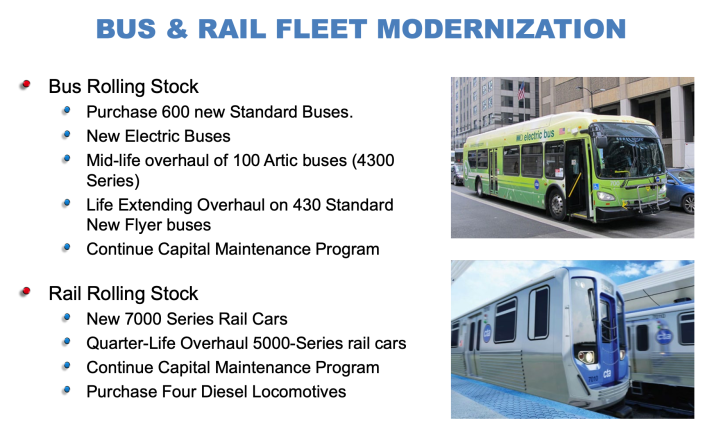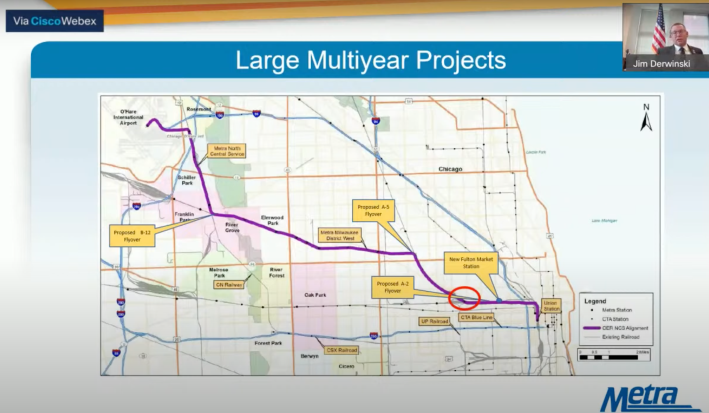If additional federal pandemic aid for transit doesn't come through, it’s not a question of whether the CTA, Metra and Pace will need to consider making drastic service cuts, but when. During the Regional Transportation Authority's board meeting last week, the heads of the three agencies presented their budgets and explained exactly how big their deficits will be, and how long the current federal Coronavirus Aid, Relief, and Economic Security Act funding can staunch the bleeding.
Pace, which has seen less ridership loss than the CTA and Metra, is in somewhat better financial shape. The suburban bus system currently expects to be able to make the funding last until 2022. But even then, the cuts may need to be severe. For the CTA, the cliff is looming this April, while Metra is planning to stretch the funding as long as possible while making $70 million in cuts.
CTA president Dorval Carter, Metra president Jim Derwinski, and Pace executive director Rocky Donahue argued that it's important for society that transit service be preserved. If and when a COVID-19 vaccine is distributed and life returns to relative normalcy, large-scale commuting will once again be a thing, and public transportation needs to be available as an alternative to driving. They said that maintaining service levels will not only require more federal aid, but will also require that the state of Illinois stop reducing its funding contributions to transit, as it has done in recent years.
But while Carter painted a dire picture, Derwinski was more optimistic, arguing that, with several vaccines nearing FDA approval, ridership and revenue numbers will rebound, even if the travel patterns won’t look quite the same as before.
CTA
Unlike the other two agencies, the CTA’s service has remained unchanged during the crisis, which Carter said was necessary because essential workers rely on it and because cuts would make it harder to social distance. Mike Connelly, the CTA’s chief planning officer, said that “Bus routes on the South and the West sides of the city retained almost two-thirds of their ridership,” while routes elsewhere in the city retained about one-third. He noted that the South and West sides have more transit-dependent riders who would be more adversely impacted by service cuts,
I’ve previously covered the CTA’s budget in detail, so I’ll just say that its deficit stands for 2021 stands at $372 million and, unlike Pace, it doesn’t have enough CARES funding left to fill that gap next year. “In the previous [2008] doomsday budget, our deficit was in the neighborhood of $100 million,” Carter said. “This is Armageddon-type stuff. This is beyond doomsday. That's why we need to get the federal relief to keep our system running.”

RTA director William Coulson, who represents suburban Cook County, asked how the CTA would determine what cuts to make, and whether there are any cuts that would be relatively painless. Carter responded that any “low-hanging fruit” was cut in the earlier rounds of cuts over the past 10 years. “With every cut, I lose revenue, so we’d have to cut deeper,” he said. ‘What I'd be doing now, if I have to, is really cutting to the bone. That's why I'd loathe to do this.” Carter declined to elaborate, saying only that the service cuts “would be painful and it would be thoughout the entire system.”
Director Jamie Gathing, who also represents suburban Cook County, pressed Carter on when the cuts might be announced in the event that there is no federal aid. Carter responded that since the CTA expects the CARES funding to last until April, they would need to announce potential cuts in February.
Metra
Derwinski said commuter railroad will be able to stretch CARES Act funding into 2022. But, unlike Pace, that statement came with caveats. It assumes that Metra ridership will increase to 50 percent of pre-pandemic levels by the end of 2021 and, unless there’s further federal aid, the railroad would need to cut $70 million. He added that without aid the deficit could reach as much as $570 million over next three years.
As Derwinski noted at earlier Metra board meetings, he told the the RTA board that commuter rail service will look different post-pandemic than it did before the crisis. He mentioned plans for more consistent intervals between trains, as well as revamping express services and looking at different reverse commuting options. He also noted that there will be a transition period where Metra will need to run more trains than ever before as the current spike in cases subsides but social distancing is still be necessary to prevent transmission.
Metra currently projects that ridership will recover to 80 percent of pre-pandemic levels by the end of 2022. Derwinski added that, with the increased prevalence of telecommuting fueling interest in suburban real estate, Metra's strategy should capitalize on that trend.
Aside from the upcoming Metra capital projects discussed in this previous Streetsblog post, Derwinski mentioned several multi-year initiatives, including the project to grade-separate Milwaukee District/Central Service tracks and Union Pacific West tracks near the Western Avenue Metra station, and improving signals and adding flyovers to the North Central Service Line to allow for more frequent service to O’Hare Airport.

Director Pat Carey, who represents Lake County, asked whether Metra’s ridership projections were too optimistic, and what they were based on. Derwinski acknowledged that there are many unknowns, but added that rebounding ridership in September (by 10 percent week-to-week) before the latest COVID wave, makes his agency optimistic that a similar rebound will happen once the public health situation improves, especially if an effective vaccine is introduced.
“One thing that's certain is that face-to-face business is coming back,” Derwinski said. "We clearly don't believe it's going to be five days a week, and that budget number is going to have to be refined as more real data comes in.”
Carey also wondered when Metra might have to start making decisions about service cuts. Derwinski said that “belt-tightening” decisions would be made during the second quarter, but emphasized that there were still too many unknowns to decide on anything more concrete. “I believe the data will be key to making those decisions, and the data doesn't exist yet." Later during the meeting, Derwinski said Metra will try to make as many internal cuts as possible before reducing service as a last resort.
Pace
Donahue said that, while Pace originally expected to lose a little over $83.1 million due to the pandemic, thanks to the combination of service suspensions/reductions, layoffs, and higher than expected farebox and tax revenues, that estimate has since been revised to only about $31.7 million. Pace has been using CARES Act revenue to cover that loss. If this positive trend continues, the agency can keep using CARES funding through 2021, with about $26.8 million available to fill the projected $55.7 million budget hole in 2022.
But Donahue warned that if Pace isn't so lucky, the agency will face a financial crisis sooner. “I cannot stress enough, without another round of federal assistance, we face serious budget challenges at the end of 2021 and the beginning of 2022."
Complicating the matter is that Pace ridership declines haven’t been distributed evenly. Some routes have thousands of riders a day, so Pace has to run extra buses on them to ensure passengers can social distance. And Donahue noted that there is one area where Pace has seen ridership growth, commuter routes to USP facility in Hodgkins and the Amazon facility in Monee. He specially mentioned that ridership for Route 395, which links the 95th/Dan Ryan Red Line station and the UPS facility, and Route 360, which connects the Harvey Transportation Center and the Amazon facility, has more than doubled. “Where we used to have 40 people a day taking the buses out of Harvey, 100 people showed up, and we had to put extra service out. And then same thing at [Route 395], so we had to put three buses out.”

If CARES funding does run out in 2022 and there is no further federal aid, Donahue said, Pace will have to reduce administrative costs and “look at potential service reductions and potential fare increases.”
He added that the cuts wouldn’t come all at once. Throughout 2021, he will be proposing “budget-balancing budget actions” to the board to try to make the CARES funding last as long as possible. While Donahue didn’t elaborate on what cuts Pace might make, he said that the principle they’ve tried to follow during the pandemic is to ensure riders have some alternative ways of reaching their destinations, even if the alternative is longer and more complicated, as well as trying to make sure the cuts don’t disproportionally impact any one area.
Like other agencies, Pace will continue to do capital projects, which are funded through state and federal sources anyway, so they are not directly affected by the aforementioned budget hole. Donahue spotlighted new bus garages in Markham, Wheeling, and Plainfield. He noted that the Wheeling garage, which will replace the existing Des Plaines garage, will allow Pace to use compressed natural gas buses on the northwest routes, saving on fuel on the long run. And he mentioned that Pace is working with the Illinois Department of Transportation to add a “flex lanes,” which become bus-only lanes during rush hour, to the Tri-State Tollway as part of the highway reconstruction project. Pace already has something similar on parts of Stevenson and Edens expressways.
While Donahue acknowledged that there have been questions about Pace doing capital projects during the pandemic recession, he believed that those investments will ultimately help the Chicago area recover. “We believe it's going to be a bright future. We believe we're going to be part of the solution, for the region, and we're going to plan for it.”





